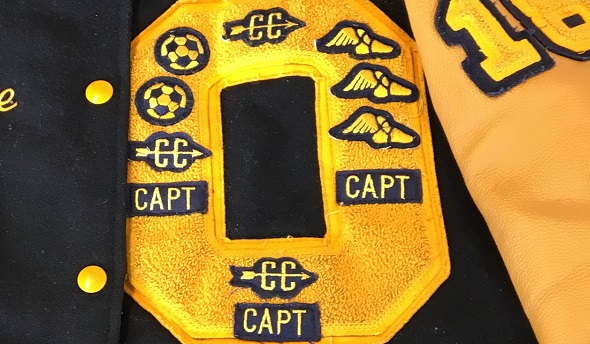
Serving a Balanced School Sports Diet
May 1, 2018
By John E. “Jack” Roberts
MHSAA Executive Director
If you really want to know what a person thinks is important, look at that person’s calendar and checkbook or credit card receipts. How a person spends his/her time and money tells you more than anything that person says.
The same can be said for organizations. How they spend their time and money identifies what they value.
So, an observer of the Michigan High School Athletic Association might notice that the only standing committee that meets more than once each year is the MHSAA’s Junior High/Middle School Committee, and the MHSAA’s longest-standing work group is the Task Force on Multi-Sport Participation, which has had six formal meetings during 2016 and 2017.
Promoting multi-sport participation, and doing so before students reach high school, is a documented MHSAA priority. We believe it’s good for students, schools and society.
By encouraging participation but not specialization, balanced multi-sport participation provides the sweet spot between two unhealthy extremes – on the one hand, inactivity that contributes to a childhood obesity epidemic or, on the other hand, year-round specialization that is too early, intense and prolonged, leading to an epidemic of overuse injuries in youth sports.
Within the pages of this issue of benchmarks are descriptions of initiatives to elevate the profile of school-sponsored sports programs for junior high/middle school age youth and to under-gird multi-sport participation as the means to maximize benefits for students and schools today, and for society in the future.
***
The MHSAA is tailoring efforts to put the multi-sport athlete back in style. Among the initiatives is bolstering participation at the junior high/middle school ages.
By Rob Kaminski
MHSAA benchmarks editor
Saugatuck’s high school football season had just come to an end with a 21-0 loss to Pewamo-Westphalia in the MHSAA Division 7 Final last November when three key players were being led up the tunnel to represent the school for postgame media interviews.
When asked how many on the team would have a one-day break before joining the basketball team for practice on that Monday, one of the players replied, “We have about seven of us who begin basketball Monday.”
The response was comforting to hear in an age that has seen specialization and year-round, single-sport focus render the multi-sport student-athlete to minority status in many hallways across the nation’s high schools.
 Granted, participation in multiple sports is necessary for programs to exist in smaller schools such as Saugatuck, but even those communities can benefit from a renewed emphasis and earlier introduction to school-based athletics.
Granted, participation in multiple sports is necessary for programs to exist in smaller schools such as Saugatuck, but even those communities can benefit from a renewed emphasis and earlier introduction to school-based athletics.
As MHSAA Executive Director Jack Roberts points out above, there are just two groups that meet more than once each year at the offices in East Lansing: the Junior High/Middle School Committee, and – during the past two years – the Task Force on Multi-Sport Participation.
Each will continue to play pivotal roles in promoting increased participation, one by examining early introduction to school sports at the junior high/middle school level, and the other by evaluating education, cooperation and recognition of multi-sport numbers at the high school age.
“One of the challenges we currently face is that in some cases students enter high school never having experienced school sports,” said MHSAA Assistant Director Cody Inglis, who oversees the Junior High/Middle School Committee. “Now they go cold-turkey into high school sports and we have to introduce them to rules and regulations that aren’t a fabric of non-school sports which they may play. The earlier we can expose them to our programs, the better off we’ll be at the high school level.”
Inglis outlined three main topics in front of the Junior High/Middle School Committee currently: 1) how to introduce school sports to students earlier; 2) the effect more games – not length of season – would have on JH/MS participation, and 3) whether the MHSAA should sponsor Regional tournaments in select sports prior to high school age.
The Task Force on Multi-Sport Participation, meanwhile, has turned its focus on the following: 1) educating groups on the benefits of variety in participation and the perils inherent in specialization, 2) preparing tools for administrators, and 3) creating recognition programs for multi-sport student-athletes.
The following are results from a fall 2017 survey on junior high/middle school programs and explanations of tools created by the multi-sport task force to encourage participation for all seasons.
Start in the middle ... or even before
The prevailing sentiment among athletic administrators, coaches and student-athletes themselves is that early introduction to a variety of sports will foster a culture of future participation and the tendency to continue in more than one sport.
“Students at the JH/MS level need to experience sports sampling so that they can be physically literate; to gain competence and confidence to move their bodies in a variety of movements so that they can achieve lifelong health and wellness and stay injury-free,” said Scott Przystas, teacher and coach at Grand Haven Area Public Schools and member of the MHSAA Task Force on Multi-Sport Participation.
The overriding question is how to strike a delicate balance between opportunity and excess at the target age group.
The good news is that MHSAA JH/MS membership has increased by more than 100 schools during the last two years, bringing the total to nearly 800. The MHSAA is exploring means to ensure the trend continues, surveying the schools last fall on matters such as modifying the Limited Team Membership rule to allow student- athletes at the JH/MS to compete in up to two outside events in the same sport in the same season, having the MHSAA sponsor regional or even state competitions in certain sports and expanding the number of JH/MS games and contests allowed during the 13-week season.
“The survey attempted to answer several questions,” Inglis said. “Would opening up options to participate in a couple non-school events during the same season draw athletes to our JH/MS programs or keep them in non-school sports? Would statewide or regional tournaments be attractive?”
Survey results reveal the current climate pertaining to several topics.
Of the 616 completing the survey, 436 were athletic directors and 166 were principals, with the remainder consisting of other positions within the schools, ranging from coaches to superintendents. The grades served by the schools were 6th-8th, with about 36 percent indicating that 5th-graders were also in their buildings.
“The survey response has shown there’s a definite hesitation for state tournaments at the JH/MS level, but there is some favorable feeling toward regional tournaments,” Inglis said.
For example, when asked about the possibility of regional tournaments in track & field and/or cross country, the results were about 50/50 for and against.
Yet, when it comes to the idea of statewide tournaments in those sports, the attitude changes significantly, with roughly 30 percent in favor. Further, when the question of JH/MS state championships for any other sports is posed, the response is an overwhelming “No,” from 84 percent of those surveyed.
Following is a sampling of comments regarding postseason tournaments at the JH/MS level:
• “Middle school athletics should be a time to expose students to the sport and develop their skills. Increasing the competitiveness of it would change the focus.”
• “Logistically, it would create more challenges to have regional and state tournaments at the middle school level. However, we are at the point where we are in a struggle competing with club sports such as basketball and soccer, to name two. At a minimum, a regional championship would create additional buzz and competitive atmosphere at the school setting. A state championship is not as critical. However, if we do this for one sport, we will have to consider doing this for all sports.”
• “I think we are headed down a dangerous path of too much too quick for junior high kids. They can play for championships in high school and beyond if they are good enough. More games mean less practice, more expense and less of a focus on the things that are important.”
• “I think middle school sports is a great opportunity to expose students to sports. We need to keep it pure with learning each day without the pressure of trying to win trophies and medals.”
• “State championships at a younger age will just start the clock earlier of recruiting and illegal transfers. Add more games to be competitive with the non-school sports.”
That last sentence hits a couple hot buttons. Can more games be added while maintaining an appropriate amount of competition? Can an environment be created to pull students from, or co-exist, with non-school options at the JH/MS level?
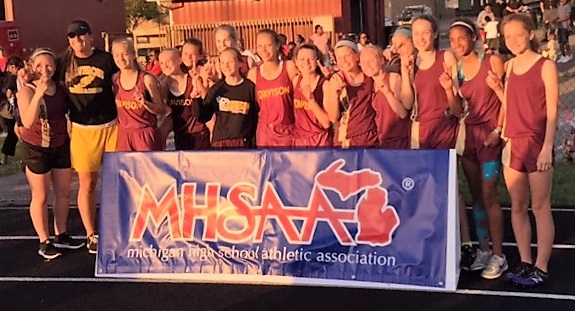 “Overall, our JH/MS constituents do not want to lengthen athletic seasons, but there is some opinion to increase the number of contests within the current seasons, particularly on days not followed by school days,” Inglis said.
“Overall, our JH/MS constituents do not want to lengthen athletic seasons, but there is some opinion to increase the number of contests within the current seasons, particularly on days not followed by school days,” Inglis said.
For example, respondents indicated just 45 percent were in favor of increasing the number of basketball games in a season from 12 to 15, while only 39 percent would support the same increase in soccer schedules.
However, support resonated with the notion of allowing multi-contest events on days not followed by school days.
The group in favor of the above scenario was also 83 percent in favor of limiting such doubleheader dates to four per season.
In soccer, a similar scenario also was approached in the survey.
Basketball and soccer are two sports in which non-school entities offer plenty of competition for participants, even at ages prior to JH/MS.
For youth already involved in such programs prior to reaching local junior highs and middle schools, the challenge is to display the benefits of school-based sports.
Justin DiSanti is a doctoral student and research assistant at Michigan State University with a concentration in sport psychology who also serves on the multi-sport task force for the MHSAA. His research interests include talent development and sport specialization, particularly in youth and high school sports.
DiSanti points to a model that is frequently used in the world of youth sport, the Developmental Model of Sport Participation (DMSP).
“This model has three stages providing approximate age guidelines and associated recommendations for shaping youth athletes’ schedules,” DiSanti said. “I believe that this model is highly-applicable to today’s world of youth sport, but the proper interpretation of the model is critical. When looking at specialization through the lens of the DMSP, we can begin to answer the question, ‘Is an athlete specializing too early?’”
The first stage, “The Sampling Years,” affects children from 6 to 12 years old, during which time participation in a wide range of athletic endeavors is encouraged. By this model, many youngsters are already thinking about specializing, or at least narrowing their focus by the time they arrive at junior highs and middle schools.
Przystas, the 2016 Michigan Physical Education Teacher of the Year by the state’s chapter of Society of Health and Physical Educators, concurs that this is a key time for future student-athletes.
“I think the multi-sport message needs to start from the ground up, with elementary physical education teachers, continuing to middle school PE and middle school sports and then into high school,” Przystas said.
In an effort to ease the transition from community and club teams, or to introduce students to sports in a school setting, JH/MS programs are critical. Leaders were asked whether allowing some non-school participation in the same sport during the same season would create a viable bridge leading to school sports participation.
The vote was nearly split when considering the allowance of two non-school events for team and individual sports per season for current MHSAA JH/MS student-athletes, with 54 percent of respondents in favor.
Yet, 63 percent believe that scenario would create conflict between the two options, and the feeling was again split as to whether such an allowance would increase or decrease participation in either the school or non-school setting.
With the degree of uncertainty as to the effect of non-school allowances, some think it best to focus on the many unique benefits offered through school sports which are lacking in alternative settings.
“I think it is important for student-athletes at this level to understand what having school pride means,” Przystas said. “When they are playing with their school logo on the front of their jersey they are representing something bigger than themselves. It is important for the coach/teacher/administrator to emphasize the importance of history and tradition not only in sports, but in other endeavors such as Science Olympiad or Spelling Bee.”
Following is a sampling of comments regarding non-school relationships at the JH/MS level:
• “Junior high is a great time for kids to increase their skill, and for many kids who don't have parents to tote them to clubs and travel teams to try the sport.”
• “It is understood that in many areas, getting kids back from travel teams is important, but in our area finding gym time, etc., is very tough.”
• “I'm uncomfortable with allowing just two non-school sporting events; I have no idea how that will be monitored. I would rather allow it or not.”
• “My biggest concern for a middle school student to play on multiple teams during the season is safety. Their bodies are still growing and I see injury being the biggest concern.”
• “School-sponsored, MHSAA sports being offered by any particular school, should take precedent over any non-school sponsored sport being offered at the same time.
• “We have a lot of football players choose to play with area little league teams instead of our school team. The non-school teams have the opportunity to play more games than our school team and they also have the opportunity for playoffs. We are limited to six games and we have academic requirements that non-school teams don't have.”
• “In my opinion, kids are going to play for either the school or play outside. Many parents are of the mindset that their child is a star and playing travel sports will get them noticed. MS sports can't compete with this mindset and I believe we should not compete with it. Those who stay and play for schools are the ones we should be focusing on. Let's make it (a) better situation for them.”
The MHSAA also carries with it something else that other organizations lack: a brand. That much came through in the spring of 2017 when a pilot program on “Presenting Sponsorship of JH/MS events” was completed.
MHSAA staff visited five areas of the state and joined in presenting pre-existing track & field league or conference meets with branding presence and financial support.
“One of the big takeaways was the power of the MHSAA brand,” Inglis said. “Student-athletes flocked to get pictures with the MHSAA banner behind them and with their trophies or medals won. The power and positivity of the MHSAA brand is something that will be used to get additional JH/MS programs into school membership.”
Future plans include sponsorship at conference events that already exist in numerous other sports.
Multiple choice is the best answer
The meeting room where the MHSAA Task Force on Multi-Sport Participation gathered for its sixth meeting over a two-year span last November was plenty big enough for the group.
But, it would never contain all of those involved in school sports to whom the task force wishes to convey its message.
Therein lies the purpose and challenge of this most important group of individuals: how to get the attention of the desired audiences, and how to best deliver the virtues and benefits of multi-sport participation.
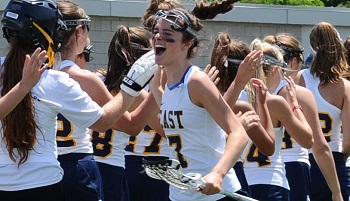 One task force member equated it to so many parent-teacher conferences; the parents that need to attend, do not. While it is universally accepted that specialization leads to burnout and detracts from the full school sports experience, all too often the two groups with the most influence – parents and coaches – are fine with that notion as long as it’s someone else’s kid, or someone else’s player.
One task force member equated it to so many parent-teacher conferences; the parents that need to attend, do not. While it is universally accepted that specialization leads to burnout and detracts from the full school sports experience, all too often the two groups with the most influence – parents and coaches – are fine with that notion as long as it’s someone else’s kid, or someone else’s player.
“One obstacle to multi-sport participation are parents. They need to understand that by having their student-athlete play one sport year-round does not guarantee a full athletic scholarship,” Przystas said. “The benefits of exposing their student athlete to a variety of sports needs to be reiterated by coaches and ADs.”
Athletic directors can further assist in the movement by coordinating coaches within their schools.
“The high school coaches need to be on board with encouraging their athletes to play multiple sports and must understand the benefits they will receive from it in the long run; athletes will not be burned out, will still have another level to at which to compete, will be willing to learn, healthy and uninjured,” Przystas said. “I think the message should be advertised in middle school events that the MHSAA sponsors as well as throughout communities and at youth level leagues.”
And, the younger the better in terms of sampling a wide variety of activities, thus preparing students for the opportunities that await them as they move through the school system.
“I believe the message needs to be heard at the elementary and middle school levels,” St. Joseph athletic director and task force member Kevin Guzzo said. “Any type of informative flyers or public service announcements touting the benefits of multi-sport participation would help educate parents on this message.”
That is the task of the group, which is currently considering numerous methods to apply the force.
Prior to the November meeting, a brochure entitled “Coaching Our Coaches” was produced and disseminated statewide, and posted to the Multi-Sport Participation page of MHSAA.com.
An accompanying PowerPoint presentation was presented by Przystas at a state conference for physical education professionals in October. Feedback from the presentation led to modifications in the PowerPoint. Among the modifications were slides less directed at the audience and more toward what the audience can do to help promote the initiative.
“The feedback from that first presentation showed us that we need to acknowledge the very many aspects of the problem, establish a positive tone, set realistic expectations and goals for the session, and identify target audiences – perhaps parents and coaches,” said MHSAA Executive Director Jack Roberts. “We might ask audiences how they can put the right people in place and what methods they use to promote the multi-sport experience to athletes, parents and coaches.”
Further educational tools and settings also have been discussed. Any time gatherings of MHSAA constituents take place, the time is ripe for delivering the message – including sportsmanship summits and coaches association meetings.
The medium for delivery must reach far beyond print and personal interaction. Social media will play a key role in advancing multi-sport participation initiatives with great frequency,
Ultimately, the task force concluded that the best way to influence and shape the culture of school sports moving forward is to recognize those schools and individuals who are living the multi-sport life and reaping the benefits.
"Recognizing Our Best" has been created and will be fluid in its content, periodically updated and delivered electronically to recognize exemplary efforts.
Some discussion took place regarding the creation of MHSAA or MIAAA awards to recognize efforts in promoting multi-sport participation, but the consensus was that local efforts and existing success stories will get greater results.
“We have implemented a program called the Iron Bear Club at our school that rewards those who are three-sport athletes,” Guzzo said. “Numbers have slightly increased over the last few years and we are hoping to continue to see an increase. Students who are three-sport athletes receive an ‘Iron Bear’ shirt, and we celebrate them on social media.”
Local efforts serve to strengthen relationships within school buildings and school systems.
“Coaches – both of in-house school-sponsored sports and private club coaches – need to be on the same page as to what is best for the athlete long-term and what advice they are giving their athletes once their season is over,” Przystas said. “This is a big obstacle that needs attention because some coaches are selfish and want what’s best for themselves and will do whatever they can do to win.
"Coaches – especially middle school and subvarsity coaches – need to understand that no one cares what their record is, but rather whether the student-athletes are having fun and continuing with school-sponsored athletics after their season is over.”
PHOTOS: (Top and top middle) Letter jackets from Owosso and Fenton, respectively, display recognition for high school athletic careers with plenty of variety. (Middle) Davison athletes pose with an MHSAA banner at a junior high event. (Below) East Grand Rapids lacrosse players high five before a game.
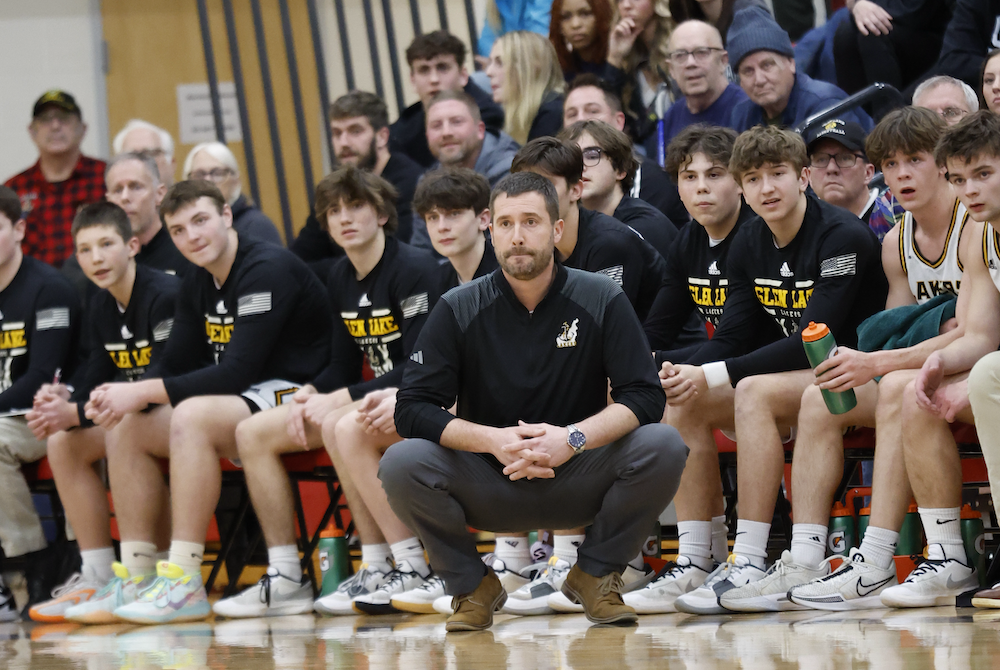
After Leading Glen Lake Girls to Title, Bradford Brings Boys Into Final Week
By
Tom Spencer
Special for MHSAA.com
March 15, 2024
Eight is Enough.
 Or is it?
Or is it?
For Jason Bradford growing up on the farm of Arden and Lynn Bradford as one of their eight children, it probably was enough. Bradford’s upbringing may have been slightly similar to “Eight Is Enough,” a comedy-drama television series about a family with eight children that aired on ABC from March of 1977 to May of 1981.
But the show didn’t depict pick-up basketball being played in the barn like it was for Bradford and his siblings. And surely eight would not be enough Regional basketball championships for Jason Bradford, nor enough District titles either.
After leading Maple City Glen Lake to the Division 4 girls basketball championship last year, Bradford stepped down from coaching. At the time his teams had won five Regional and six District titles.
Now his teams have won six Regional and seven District championships. He took over Glen Lake’s boys program during the holiday break this winter as the Lakers were off to a 4-2 start. They finished the season 22-5.
It was the Lakers boys’ first 20-win campaign since the 2018-19 season, and they clinched their first Regional title since 2018.
Glen Lake went 19-5 last year losing to Traverse City St. Francis in the District Final. The season before that ended with a first-round loss to Elk Rapids and 15-6 record.
Bradford led his girls teams four times to the MHSAA Semifinals and almost got their a fifth time this year with the boys. Their run ended Tuesday with a tough loss in the Division 4 Quarterfinals to Mount Pleasant Sacred Heart, 63-51.
“We’re licking the wounds of that one,” he said. “We’ve got to remember to look at the big picture – they are young men becoming men.”
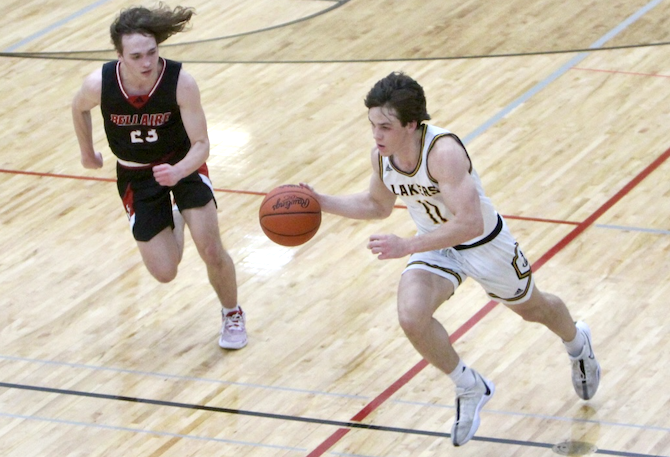 But Bradford already has turned his thoughts to next season and is making plans for summer basketball.
But Bradford already has turned his thoughts to next season and is making plans for summer basketball.
“Having the summer with them if it goes the way we want is going to be huge,” Bradford said. “There are a few things going through my head I can change or adjust.
“We want to continue to build on what our philosophy of what Glen Lake is and my philosophy of what Glen Lake is.”
The Lakers will graduate Cooper Bufalini, Gage Baker, Dylan Cundiff, Tyler Bixby and Jamie Blondia. But they’ll have their top two scorers back, sophomore Jacob Plamondon and junior Benji Allen. Plamondon kicked in almost 20 points per game and led the team in rebounding with more than 10 per contest. Allen averaged more than 11 points per game and led the team in assists.
Glen Lake finished second in the Northwest Conference behind Benzie Central, which was undefeated in league play. The Lakers knocked off league opponents Frankfort in the Division 4 District title match and Buckley in the Regional Semifinal.
The battles with Benzie for the conference title may have been the highlights of the season, Bradford noted. Those were Glen Lake’s only losses in league play, and a share of the title was within their grasp late in the second game with the Huskies.
The Lakers lost 60-51 on their home court in the first meeting but took Benzie to the limit in the rematch before falling, 41-39, on the road.
“We had a lot of great games and a lot of great memories,” Bradford said. “Going for conference it pretty much came down to the last few seconds with lead changes.
“We were up by one point with less than 30 second lefts, and that was the high point,” he continued. “We came up short, but we learned from that game.”
Also among highlights for Bradford this year was the chance to coach against his brother Nathan for the first time in their careers.
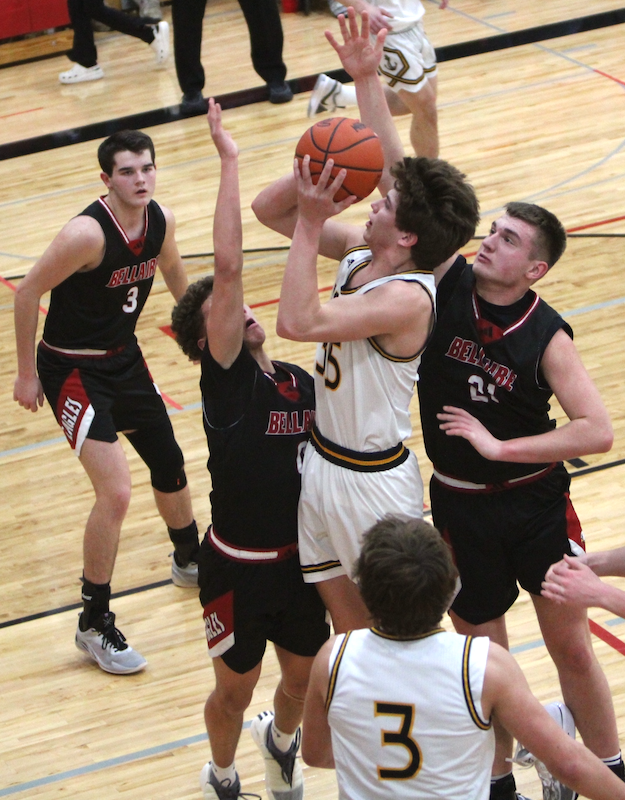 The Bradfords started coaching girls varsity basketball 16 years ago, but their teams were in different conferences at the time. Nathan coached the Onekama girls but moved to the boys program before Onekama and Glen Lake had a chance to compete against each other in the Northwest Conference.
The Bradfords started coaching girls varsity basketball 16 years ago, but their teams were in different conferences at the time. Nathan coached the Onekama girls but moved to the boys program before Onekama and Glen Lake had a chance to compete against each other in the Northwest Conference.
The Bradford coaches often talk after their games and learn from one another. They have also seen their parents frequently in the bleachers as they rotate home game sites to see their grandchildren play and their sons coach.
When Onekama and Glen Lake played this year, eight Bradfords were on the rosters as players or coaches. Jason’s son Toby, a freshman, played on the Glen Lake junior varsity team, as Nathan’s son Carson played for the Portagers’ JV squad. The Onekama JV team is coached by another Bradford, Jason and Nathan’s brother Nick. And there were three more Bradfords on the varsity – Nathan’s son Caden and his cousins Luke and Arden.
Glen Lake won both varsity games, 38-36 at Onekama and 61-33 at home.
Jason and his wife Jackie have five children. Their youngest son, Drew, is now a sixth grader at Glen Lake. His oldest son, J.J., is at Michigan Tech and has begun officiating basketball after his senior season at Glen Lake cut short by the pandemic while the Lakers were preparing to play in a 2020 District Final. Daughters Maddie and Grace are playing basketball for Lake Superior State University.
Maddie and Grace were big parts of Glen Lake’s deep postseason runs with Jason as girls coach. With many games played on Saturdays and not conflicting with coaching, Jason, Jackie and the younger boys were able to travel to see the Upper Peninsula’s Lakers play regularly.
This season, the Glen Lake girls – under first-year head coach Brad Fosmore – went 16-8 and won Northwest Conference and District titles before losing a nail-biter, 45-42, to league rival Frankfort in the Regional Semifinal.
“Jason did a good job, and it felt good to carry on the tradition,” said Fosmore, who previously served as a Lakers JV coach. “We took it one game at a time.
“Jason worked hard to build a great girls program,” he continued. “It made it pretty simple because they had that winning tradition and kind of kept it rolling.”
 Tom Spencer is a longtime MHSAA-registered basketball and soccer official, and former softball and baseball official, and he also has coached in the northern Lower Peninsula area. He previously has written for the Saginaw News, Bay County Sports Page and Midland Daily News. He can be reached at [email protected] with story ideas for Manistee, Wexford, Missaukee, Roscommon, Ogemaw, Iosco, Alcona, Oscoda, Crawford, Kalkaska, Grand Traverse, Benzie, Leelanau, Antrim, Otsego, Montmorency, Alpena, Presque Isle, Cheboygan, Charlevoix and Emmet counties.
Tom Spencer is a longtime MHSAA-registered basketball and soccer official, and former softball and baseball official, and he also has coached in the northern Lower Peninsula area. He previously has written for the Saginaw News, Bay County Sports Page and Midland Daily News. He can be reached at [email protected] with story ideas for Manistee, Wexford, Missaukee, Roscommon, Ogemaw, Iosco, Alcona, Oscoda, Crawford, Kalkaska, Grand Traverse, Benzie, Leelanau, Antrim, Otsego, Montmorency, Alpena, Presque Isle, Cheboygan, Charlevoix and Emmet counties.
PHOTOS (Top) Jason Bradford, kneeling, coaches the Maple City Glen Lake boys varsity after taking over the program earlier this season. (Middle) Glen Lake’s Cooper Bufalini (11) pushes the ball upcourt during a 65-49 District Final win over Bellaire. (Below) The Lakers’ Jacob Plamondon (35) makes a strong move to the basket. (Top photo by RD Sports Photo/Rob DeForge, additional photos by Nicole Bixby.)

